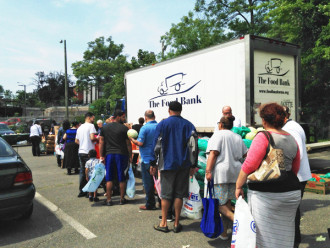Providing more healthy food to families across the region
By Andrew Morehouse,
Executive Director
Is child hunger a myth? Bill O’Reilly of the O’Reilly Factor certainly thinks so and said so earlier this month on Fox News. We have a serious societal challenge on our hands when there are people in important positions of influence who believe that children do not go hungry in the United States of America. The fact of the matter is that there are tens of thousands of children in Western Massachusetts alone who go to school hungry, especially on Mondays, because there isn’t adequate food at home. If you don’t believe me, ask just about any elementary school teacher from your local school.

Families receive fresh food from our Mobile Food Bank
According to Feeding America, the national network of food banks, there are an estimated 33,580 food insecure children in our four-county region (Berkshire, Franklin, Hampden and Hampshire counties) on any given day of the year. That’s one in five individuals under the age of 18. Of these, 22% (or about 7,000 children) are from households whose incomes are above the eligibility threshold for access to federal nutrition programs. This means that they don’t qualify to receive SNAP (food stamp) benefits; yet their income is still too low to pay for basic household expenses and put adequate food on the table.
In response, The Food Bank of Western Massachusetts and food banks across the country are evolving to provide more nutritious food — especially fresh produce — than ever before. You see, we believe that everyone has a right to healthy food regardless of their circumstances. In the last twelve months, we distributed just shy of 10 million lbs. of food (or the equivalent of 8.3 million meals) — the maximum amount of food that I was told our food bank could handle when I started 10 years ago. Of this total, about a fifth is fresh produce; most of it comes from local farms, including 160,000 lbs. from our own Food Bank Farm in Hadley in partnership with Mountain View Farm CSA.
In order to achieve this impact in communities across our region, we’ve invested in a huge new cooler in our Hatfield warehouse with seven glass doors to make it easy for local feeding programs to take fresh produce back to their neighbors in need in their communities. We’ve also awarded close to$34,000 to 11 local feeding programs to purchase smaller commercial freezers and coolers to be able to store fresh produce and other perishable foods that they receive from The Food Bank – the largest source of food for all 230 local feeding programs in our region. In addition, with our new 24-foot refrigerated Mobile Food Bank truck, we delivered approximately 736,000 meals, especially produce and other healthy perishable food items, over the last 12 months to more than 21,638 individuals, including 7,879 children. We have partnered on this new initiative with thirteen community-based organizations either once or twice a month, mainly in Springfield and Holyoke, where rates of food insecurity are the highest in our region. We have focused this initiative in Hampden County where on average households at risk of hunger have less access to emergency food than similar households in the other three counties of our region.
Despite this tremendous undertaking with our community partners and the investment of thousands of donors, this amount of food assistance is still not enough to prevent more than 235,000 children, adults, and vulnerable elders from having to skip meals. Tapping into federal nutrition programs, we also enrolled 867 individuals in the last 12 months in the Supplemental Nutrition Assistance Program (SNAP), formerly food stamps. Since SNAP is 100% federally funded, this assistance will result in more than $3.7 million of additional local economic activity over the course of the year, not to mention much-needed food to nourish these individuals.
Moving forward, we are committed to rolling out even more innovative approaches to further our mission of feeding our neighbors in need and leading the community to end hunger. The Food Bank’s Board of Directors and staff are currently studying the feasibility of purchasing and operating a second farm. In addition, we are now collaborating with the EOS Foundation in Boston to promote the adoption of school breakfasts in the classroom as a proven strategy to increase student participation in the federally-subsidized school breakfast program. Public schools across the Commonwealth are demonstrating that children are more engaged in the classroom and learn more and better, and that classroom disruptions and visits to the nurse for “tummy aches” decline when children eat breakfast…who would have thought?!
We know that we can’t food bank our way out of hunger in America. Food banks alone cannot end hunger. Hunger is a societal challenge that can only be solved if and when everyone comes together with the resolve to put an end to it — non-profit organizations, private businesses and local, state and federal governments. Solving hunger requires not only a moral imperative, but also the political will to rise above narrow ideological positions and values.
Lastly, we also believe that there is no silver-bullet solution. Ending hunger will also require a comprehensive full-court press from many different angles, including (but not limited to) addressing job creation and workforce development, stagnant incomes, income inequality, homelessness, education, child care, transportation, health and nutrition. Over the course of the next year, we will engage in a dialogue with diverse community stakeholders across Western Massachusetts to chart a plan of action to end hunger in the years to come. We acknowledge this is a lofty and ambitious goal, and one that may take many more years than we wish. However, we believe that we cannot be true to our mission and pragmatic in achieving it unless we hold ourselves accountable to it and do so with community-wide participation, planning and commitment.